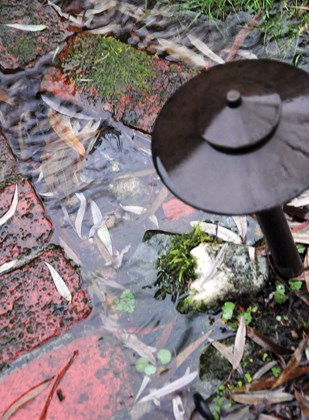The relentless rain this fall has left some homeowners inspecting the drainage around the house and garden.
Most homes have issues with water movement across and around the house. Even flat yards have drainage issues. Water runs by or through the yard, or water pools and seeps into places we don't want it to go. Homeowners rarely see the underground drainage system in their yards or under our roads. There are buried pipes that continuously flow water out of our homes from sinks and toilets. Each home also has perimeter drain pipe buried at the base of the home's foundation to drain water away from the foundation. In many gardens people have installed small catch basins to collect water or buried drain pipes under lawns and wet areas for drainage. Knowing how to maintain or repair a drainage system is a useful skill to have for anyone living on our watery planet.
Drain system basics:
Each drain system is comprised of perforated drain pipe that is surrounded by clear crushed gravel. The system has a high point and a lower outflow point where water exits the system. There are three types of drain pipe in general use for home and garden construction. ABS is primarily for interior use not garden use. Perforated PVC pipe is a rigid pipe used for perimeter drainage around the house's foundation and for garden use. And there is Big-O pipe, primarily used for agriculture production but it's widely installed for perimeter drainage and in gardens.
Drainage installation basics:
Drainage installation work is physically demanding. But more importantly, a fundamental knowledge of drainage systems and some experience is required to install it properly. If you are installing or repairing the perimeter drains around your home's foundation consult a professional to avoid serious water damage that can result from poorly or incorrectly installed drain systems. You would not believe how many times I have repaired or replaced drainage because there was a low point in the middle of the system causing flooding. Or the system had no outflow point for the water. By the way, it is against the law to intentionally direct water off your property onto a neighbour's or city property by means of a piped drainage system.
I only use perforated PVC pipe for drainage applications because it's durable, flushable and it maintains proper slope underground. Any other type of drain pipe is unreliable and problematic. Especially Big-O pipe, which does not accurately lie flat during installation and it sinks, rises or gets crushed over time.
Underground drain pipe must be surrounded with at least 12-18 inches of drain rock - more in some instances. I personally do not like round drain rock for underground drain systems because it migrates in the soil over time. Clear, crushed gravel is my preferred choice of rock for underground drainage because it has better stability, can be packed to a point and it retains the space between the stones for better water infiltration.
On the issue of landscape fabric to cover the drain rock before backfilling, there are conflicting opinions. Some engineers, municipalities and professionals believe it's necessary to cover the drain rock with landscape fabric to prevent the soil movement into the drain rock and pipe system. Others believe that fabric on top of the gravel blocks the free movement of water to the pipe. And that fabric may plug with fine sediment over time. I struggle with the issue regularly having installed both methods. Depending on the type of soil, I generally prefer no fabric (just soil on top of the gravel), with a follow up drain flush three to four weeks after installation to remove any of the initial sediment that may flow into the new pipe system.
Drain system maintenance:
All underground drain systems require occasional maintenance. Fortunately, technology has progressed to provide us with better tools to maintain underground drain systems.
The pipe camera, for example, allows the user to see inside the drain pipe to diagnose any problems in the system.
Most drain cameras can go 30-50 feet into a pipe for diagnosis. Drainage and plumbing companies have those cameras available for service if needed. Some tool rental companies rent such cameras but usually not the long ones. Water flushing to remove sediment build up is also used to keep drain systems clean and functioning.
However, flushing must be done carefully and correctly to avoid damaging the pipe or creating a blockage.
Keeping debris out of the drain system in the first place avoids the need for serious maintenance later. Downspout screens that prevent debris from the roof gutters from entering the pipe are useful. And all catch basins trap sediment in the bottom of the basin for cleaning, thereby preventing sedimentation of the pipe.
Todd Major is a journeyman horticulturist, garden designer and builder, teacher and organic advocate. [email protected]



